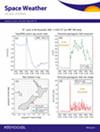Investigation of Ionospheric Small-Scale Plasma Structures Associated With Particle Precipitation
IF 3.7
2区 地球科学
引用次数: 0
Abstract
We investigate the role of auroral particle precipitation in small-scale (below hundreds of meters) plasma structuring in the auroral ionosphere over the Arctic. In this scope, we analyze together data recorded by an Ionospheric Scintillation Monitor Receiver (ISMR) of Global Navigation Satellite System (GNSS) signals and by an All-Sky Imager located in Longyearbyen, Svalbard (Norway). We leverage on the raw GNSS samples provided at 50 Hz by the ISMR to evaluate amplitude and phase scintillation indices at 1 s time resolution and the Ionosphere-Free Linear Combination at 20 ms time resolution. The simultaneous use of the 1 s GNSS-based scintillation indices allows identifying the scale size of the irregularities involved in plasma structuring in the range of small (up to few hundreds of meters) and medium-scale size ranges (up to few kilometers) for GNSS frequencies and observational geometry. Additionally, they allow identifying the diffractive and refractive nature of fluctuations on the recorded GNSS signals. Six strong auroral events and their effects on plasma structuring are studied. Plasma structuring down to scales of hundreds of meters is seen when strong gradients in auroral emissions at 557.7 nm cross the line of sight between the GNSS satellite and receiver. Local magnetic field measurements confirm small-scale structuring processes coinciding with intensification of ionospheric currents. Since 557.7 nm emissions primarily originate from the ionospheric E-region, plasma instabilities from particle precipitation at E-region altitudes are considered to be responsible for the signatures of small-scale plasma structuring highlighted in the GNSS scintillation data.调查与粒子沉降有关的电离层小尺度等离子体结构
我们研究了极光粒子沉淀在北极上空极光电离层小尺度(低于数百米)等离子体结构中的作用。在这一范围内,我们分析了电离层闪烁监测接收器(ISMR)记录的全球导航卫星系统(GNSS)信号和位于斯瓦尔巴群岛(挪威)朗伊尔边的全天空成像仪记录的数据。我们利用 ISMR 提供的 50 赫兹全球导航卫星系统原始样本,以 1 秒时间分辨率评估振幅和相位闪烁指数,以 20 毫秒时间分辨率评估无电离层线性组合。同时使用基于全球导航卫星系统的 1 秒闪烁指数,可以确定等离子体结构所涉及的不规则的尺度大小,其范围为全球导航卫星系统频率和观测几何的小尺度(最多几百米)和中尺度范围(最多几千米)。此外,它们还能识别记录的全球导航卫星系统信号波动的衍射和折射性质。研究了六个强极光事件及其对等离子体结构的影响。当 557.7 纳米极光发射的强梯度穿过全球导航卫星系统卫星和接收器之间的视线时,会出现等离子体结构化,其尺度可达数百米。当地磁场测量证实,小尺度结构化过程与电离层电流的增强相吻合。由于 557.7 nm 辐射主要来自电离层 E 区域,因此认为 E 区域高度的粒子沉降所产生的等离子体不稳定性是全球导航卫星系统闪烁数据中突出显示的小规模等离子体结构化特征的原因。
本文章由计算机程序翻译,如有差异,请以英文原文为准。
求助全文
约1分钟内获得全文
求助全文

 求助内容:
求助内容: 应助结果提醒方式:
应助结果提醒方式:


